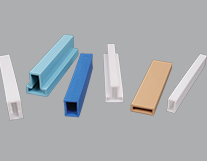
UHMW, otherwise known as Ultra High Molecular Weight Polyethylene, brings with it a wide range of benefits that can’t be ignored. Chief among these are not only its strength and its durability, but it’s ability to withstand constant friction and high impacts as well. It’s used in a huge variety of different applications including with conveyor systems, wear strips for material handling equipment and truck bed liners, just to name a select few.
But what a lot of people don’t realize is that there are actually a few different types of UHMW materials available to choose from depending on your needs. Only by understanding the needs of your application will you be able to make the decision regarding which one is best for you.
The Types of UHMW: Breaking Things Down
One of the most common types of UHMW available is known as “natural” UHMW. The base material is made up of 100% Ultra High Molecular Weight Polyethylene and its totally FDA compliant. Because it’s so easy to work with and because it exhibits all of the properties that UHMW is known for, it’s typically used in everything from custom machined parts to pulleys, chain guides and more.
Another option is reprocessed UHMW, which has all of the same properties and advantages only it’s also a bit more environmentally friendly because it’s being made from re-used materials. This would be an ideal option for those organizations who are making an effort to be more ecologically conscious than their competitors.
High temperature UHMW is also an option, which often goes by the designation HT-UHMW. The major advantage here is that the maximum operating temperature is significantly higher than that of UHMW. With the latter, you can really only safely get to about 180 degrees Fahrenheit before you start to experience issues. With High temperature UHMW, that number is increased to roughly 280 degrees. This is an ideal solution for any end application where cutting down on the amount of wear to other plastics in a finished product is of paramount importance. There are alternative materials that you could use in this situation, with Teflon being perhaps the biggest example, but none will give you the resistance and durability that UHMW can.
Finally, you have oil-filled UHMW. Here, a fluid lubricant is used throughout the material in an effort to reduce friction. This is typically employed where equipment is used at higher speeds (like a conveyor belt, for one example), or in any environment where certain components need that added bit of lubrication.
Regardless, a trusted partner like the team at Spiratex will be able to help you make the best choice given the needs of your application. They’ll help you understand the pros and cons of each type of material within the context of what you need to accomplish, all so that you can make the most informed decision possible regarding your end product.
If you’d like to find out more information about the various types of UHMW that are available, or if you have any additional questions you’d like to go over with someone in a bit more detail, please don’t hesitate to contact the team at Spiratex today.